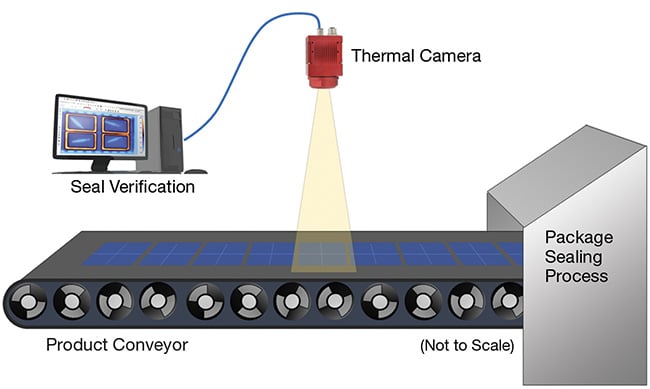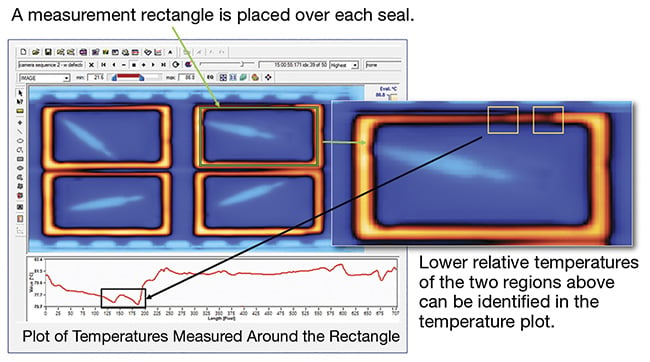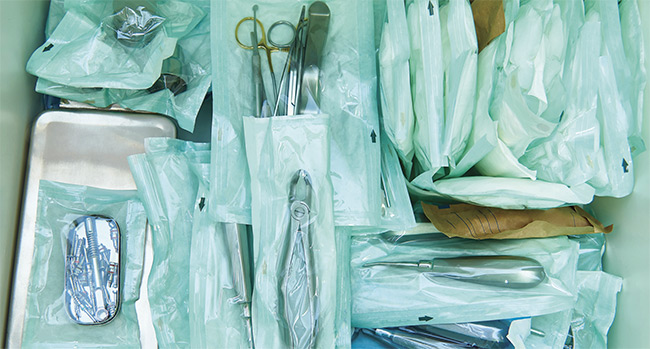HANK HOGAN, CONTRIBUTING EDITOR
Maintaining a sterile environment inside the operating room is
critical. This extends to surfaces, the garments of the surgeons performing the procedures, and the medical devices themselves.
To make sure the devices get to the operating room completely sterile, a medical device manufacturer put in place a direct heat transfer seal as the final step in the process involving the making of nonimplantable surgical
devices. Complicating matters, the packaging had to stay transparent so that members of a busy operating team could easily see its contents.

A conceptual layout of a medical device package inspection system. Parts exit the sealing process and travel down a conveyor, where a thermal smart camera inspects the seal. Courtesy of MoviTHERM.
Traditional inspection of packaged medical devices takes place in three ways. One involves taking a random sampling of pull-back force, in which a machine measures how much force would be needed to pull apart, and thus destroy, a sealed package.
Line workers also conduct two separate nondestructive visual checks on all product. The first involves inspecting for any discoloration or visible change in transparency. The presence of either may indicate problems with the heat and pressure used to create the weld seam that seals the package. The second consists of squeezing the package, as may be done when checking a plastic bag for leaks. A failure to hold air could indicate that delamination has occurred along the weld seam.
The manual nature of these inspections leads to concerns. As people get tired, their ability to catch defects diminishes. And no two people carry out the visual check and squeeze tests exactly the same. Thus, there is a nonzero chance that a package with problems will get through.
The manufacturer therefore improved its quality checks by implementing an automated vison system that uses thermal imaging to assess the quality of the heat seal.

The inspection methodology for medical device packaging. The thermal vision system identifies the package seal (green rectangle). The system then measures the seal temperature. Low-temperature regions indicate possible failure of the sealing process, which uses heat and pressure. Courtesy of MoviTHERM.
The engineering staff at systems integrator MoviTHERM, tasked with designing the vision solution, opted to use an IRSX-640 heat-sensing smart camera from AT – Automation Technology. The camera has 640 × 512 pixels in an array and is capable of rates of
30 fps. It is an uncooled microbolometer and measures temperature with ±2 °C accuracy. Because it is a smart camera, it has a number of built-in image processing capabilities and interface protocols, as well as protection against water and dust ingress, making it well suited to industrial settings.
“You can really use this as a smart sensor integral to your production line. It’s a fully embedded system,” said
MoviTHERM president Markus Tarin. “Our system is more objective than a human being because it is computerized.”
The camera works similar to a smartphone, said Cristian Ferber, senior business development and key account manager for AT. Software components inside the camera allow the implementation of an array of functions, which can be adjusted on the fly as needed.

Medical devices in transparent plastic packaging, which can be heat sealed. The integrity of the seal is assessed using thermal imaging. Courtesy of iStock.com/ViktoriiaNovokhatska.
“The different apps and configuration files can be automatically switched, providing the user of the camera with an until-now unimaginable level of flexibility and tools,” Ferber said.
When inspecting the sealed medical devices, the thermal imaging vision system looks at the packages in a 2 × 2 configuration, measuring the temperature across the 5-mm-wide weld seam with ±5 °C accuracy. The inspection happens after the parts exit a machine that seals the package using heat and pressure. Image acquisition takes about 50 ms, so pass/fail results are available quickly.
Validation using test cases demonstrated that the system can spot instances in which the temperature or pressure used in the sealing process is out of spec. By measuring seal temperature, the system detects when residue has built up on the heating plate and then sends out a warning message, thereby signaling that the heating plate needs cleaning.
Significant benefits have resulted from implementing the new thermal vision system, Tarin said. “The reliability of the inspection went up, although I’m not sure by what percentage, because [the inspection system] is not subject to fatigue. It can measure with much higher reliability and precision because it measures the entire heat seal by temperature.”